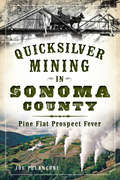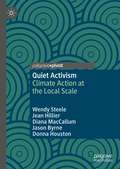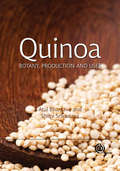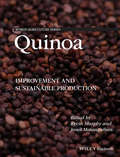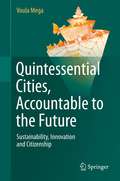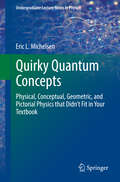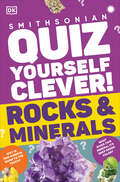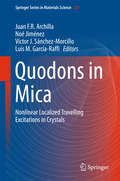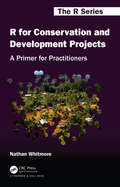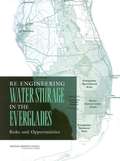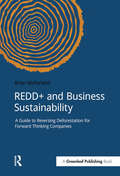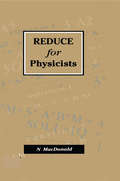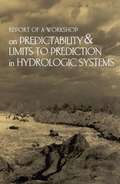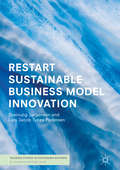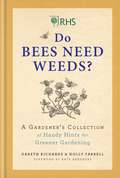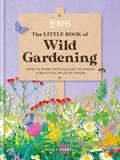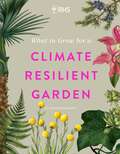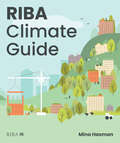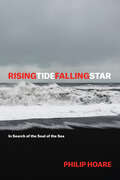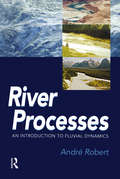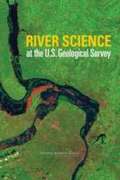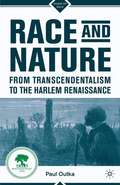- Table View
- List View
Quicksilver Mining in Sonoma County: Pine Flat Prospect Fever
by Joe PelanconiIn the 1870s, a quicksilver mining boom took hold of Sonoma County, California. Claims were staked, and a rowdy camp took shape in Pine Flat as farmers traded plows for picks and miners answered the siren call of cinnabar. In this compelling account, historian Joe Pelanconi relates the development of the twenty-mile Cinnabar Mining District. Pelanconi shares intriguing stories like those of the Donner Party survivor, Chinese laborers who worked the mines in danger of mercury poisoning and the two brothers who were leading citizens of the district and purported victims of murder. Delve into Sonoma County's heritage and a lost era when eccentrics and dreamers sought shining flasks of riches in the Mayacamas Mountains above today's wine country.
Quiet Activism: Climate Action at the Local Scale
by Jason Byrne Wendy Steele Diana MacCallum Jean Hillier Donna HoustonThis book focuses on the potential and possibilities for socially innovative responses to the climate emergency at the local scale. Climate change has intensified the need for communities to find creative and meaningful ways to address the sustainability of their environments. The authors focus on the creative and collaborative ways local- scale climate action reflects the extra-ordinary measures taken by ordinary people. This includes critical engagement with the ways in which novel social practices and partnerships emerge between people, organisations, institutions, governance arrangements and eco-systems. The book successfully highlights the transformative power of socially innovative activities and initiatives in response to the climate crisis; and critically explores how different individuals and groups undertake climate action as ‘quiet activism’ – the embodied acts of collective disruption, subversion, creativity and care at the local scale.
Quinoa
by Shilpi Srivastava Didier Bazile Enrique A Martínez Atul Bhargava Francisco Fuentes* Quinoa is an invaluable crop, highlighted by the FAO as one of the world's main crops for future food security * Timely publication - The year 2013 has been declared "The International Year of the Quinoa" (IYQ), recognizing the Andean indigenous peoples, who have maintained, controlled, protected and preserved quinoa as food for present and future generations thanks to their traditional knowledge and practices of living well in harmony with mother earth and nature. * Covers the history, phylogeny and systematics, botany and agrotechnology
Quinoa
by Kevin S. Murphy Janet MatanguihanQuinoa is an ancient grain that has grown in popularity in recent years. It has been known as a good source of both protein and fiber. As the demand for quinoa increases a comprehensive and up-to-date reference on the biology and production of the crop is essential. Quinoa: Improvement and Sustainable Production brings together authors from around the world to provide a complete assessment of the current state of global quinoa research and production. Topics covered include quinoa history and culture, genomics and breeding, agronomy, nutrition, marketing, and end-uses. The book focuses in particular on the emerging role of quinoa in providing increased food security to smallholder farmers and communities throughout the world. Quinoa will interest quinoa researchers, producers, crop scientists, agronomists, and plant geneticists, as well as advanced students working with this important grain.
Quinoa: Botany, Production and Uses (Botany, Production and Uses)
by Shilpi Srivastava Atul Bhargava* Quinoa is an invaluable crop, highlighted by the FAO as one of the world’s main crops for future food security * Timely publication – The year 2013 has been declared "The International Year of the Quinoa" (IYQ), recognizing the Andean indigenous peoples, who have maintained, controlled, protected and preserved quinoa as food for present and future generations thanks to their traditional knowledge and practices of living well in harmony with mother earth and nature. * Covers the history, phylogeny and systematics, botany and agrotechnology
Quintessential Cities, Accountable to the Future: Sustainability, Innovation and Citizenship
by Voula MegaThis book can be seen as the third part of an unofficial trilogy on Sustainable Cities of the Future with the author's previous books 'Sustainable Development, Energy and the City' and 'Sustainable Cities for the third millennium: The Odyssey of urban excellence', both prefaced by Prof. Sir Peter Hall. All three books follow the evolving forefront of innovations towards Sustainable Cities. They collectively try to respond to the questions: What future cities wish to build (with their scarcities and capacities) on a finite planet? What do-they do to achieve this? How do-they contribute to redesign the world? The third book adopts, first and foremost, a strategic foresight approach including a scan of the future trends, tensions and risks in a more uncertain world, the possible and preferable futures, emerging policy issues, such as intergenerational cities or cities welcoming the immigrants and their impact on sustainable development, the Rio+20 prospects and the effects of the protracted crisis, efforts by world interconnected cities, including a case-study on Bangkok, a laboratory of urban change, and examples of frugal and resilient urban policies.
Quirky Quantum Concepts
by Eric L. MichelsenQuirky Quantum Concepts explains the more important and more difficult concepts in theoretical quantum mechanics, especially those which are consistently neglected or confusing in many common expositions. The emphasis is on physical understanding, which is necessary for the development of new, cutting edge science. In particular, this book explains the basis for many standard quantum methods, which are too often presented without sufficient motivation or interpretation. The book is not a simplification or popularization: it is real science for real scientists. Physics includes math, and this book does not shy away from it, but neither does it hide behind it. Without conceptual understanding, math is gibberish. The discussions here provide the experimental and theoretical reasoning behind some of the great discoveries, so the reader may see how discoveries arise from a rational process of thinking, a process which Quirky Quantum Concepts makes accessible to its readers. Quirky Quantum Concepts is therefore a supplement to almost any existing quantum mechanics text. Students and scientists will appreciate the combination of conversational style, which promotes understanding, with thorough scientific accuracy.
Quiz Yourself Clever! Rocks and Minerals (DK Quiz Yourself Clever )
by DKDiscover the wonders of our rocky planet through fun quizzes.This amazing book welcomes you to Earth's extraordinary rocks, minerals, and gems, from igneous rocks formed deep inside the Earth's molten core to sparkling emeralds. Stunning pictures and fast facts will allow you to grasp a wealth of knowledge in a fun way.The pure form of every rock or mineral is shown via an eye-catching image, surrounded by quiz-style questions. Turn the page to find the answers, contained in a handy dataset of essential information. You'll be recognizing sedimentary from sandstone, metamorphic from marble, and pyrite from pearl in no time. Discover the unique qualities of each material, together with how it is used in art, industry, architecture, and science.You can use the book to test your own knowledge, or how about using it to quiz a friend? Quiz Yourself Clever! Rocks and Minerals is packed with information on the world's amazing materials—from rainbow rocks and fluorescent minerals to priceless diamonds!
Quodons in Mica
by Juan F. R. Archilla Noé Jiménez Victor J. Sánchez-Morcillo Luis M. García-RaffiThis book presents the current knowledge about nonlinear localized travelling excitations in crystals. Excitations can be vibrational, electronic, magnetic or of many other types, in many different types of crystals, as silicates, semiconductors and metals. The book is dedicated to the British scientist FM Russell, recently turned 80. He found 50 years ago that a mineral mica muscovite was able to record elementary charged particles and much later that also some kind of localized excitations, he called them quodons, was also recorded. The tracks, therefore, provide a striking experimental evidence of quodons existence. The first chapter by him presents the state of knowledge in this topic. It is followed by about 18 chapters from world leaders in the field, reviewing different aspects, materials and methods including experiments, molecular dynamics and theory and also presenting the latest results. The last part includes a personal narration of FM Russell of the deciphering of the marks in mica. It provides a unique way to present the science in an accessible way and also illustrates the process of discovery in a scientist's mind.
R for Conservation and Development Projects: A Primer for Practitioners (Chapman & Hall/CRC The R Series)
by Nathan WhitmoreThis book is aimed at conservation and development practitioners who need to learn and use R in a part-time professional context. It gives people with a non-technical background a set of skills to graph, map, and model in R. It also provides background on data integration in project management and covers fundamental statistical concepts. The book aims to demystify R and give practitioners the confidence to use it. Key Features:• Viewing data science as part of a greater knowledge and decision making system • Foundation sections on inference, evidence, and data integration • Plain English explanations of R functions • Relatable examples which are typical of activities undertaken by conservation and development organisations in the developing world • Worked examples showing how data analysis can be incorporated into project reports
RE-ENGINEERING WATER STORAGE IN THE EVERGLADES: Risks and Opportunities
by National Research Council of the National AcademiesThe Water Science and Technology Board and the Board on Environmental Studies and Toxicology have released the seventh and final report of the Committee on Restoration of the Greater Everglades Ecosystem, which provides consensus advice to the South Florida Ecosystem Restoration Task Force on various scientific and technical topics. Human settlements and flood-control structures have significantly reduced the Everglades, which once encompassed over three million acres of slow-moving water enriched by a diverse biota. To remedy the degradation of the Everglades, a comprehensive Everglades Restoration Plan was formulated in 1999 with the goal of restoring the original hydrologic conditions of its remaining natural ecosystem. A major feature of this plan is providing enough storage capacity to meet human needs while also providing the needs of the greater Everglades ecosystem. This report reviews and evaluates not only storage options included in the Restoration Plan but also other options not considered in the Plan. Along with providing hydrologic and ecological analyses of the size, location and functioning of water storage components, the report also discusses and makes recommendations on related critical factors, such as timing of land acquisition, intermediate states of restoration, and tradeoffs among competing goals and ecosystem objectives.
REDD+ and Business Sustainability: A Guide to Reversing Deforestation for Forward Thinking Companies
by Brian McFarlandThis book provides a detailed look at REDD+ business case studies and best practice and highlights the future of REDD+ in providing a promising mechanism for financing forest conservation while increasing the sustainability and profitability of forward-thinking companies. How can sustainability leaders reverse tropical deforestation? What exactly are payment for ecosystem service forest conservation projects, otherwise known as Reducing Emissions from Deforestation and Degradation (REDD+), and how can these projects contribute to business sustainability and profitability? Tropical forests are quickly disappearing – at a rate of nearly one football or soccer field every few seconds. REDD+ simultaneously offers a scalable conservation finance mechanism and a platform for business sustainability. This book focuses on the nexus between tropical forest conservation projects and the sustainability practices of major global businesses. This book contextualizes the issues, defines REDD+ and focuses on its significance to business sustainability including: the role of REDD+ in mitigating global greenhouse gas emissions while reducing business risk to a changing climate; as part of a firm’s philanthropic work; a mechanism to increase consumer loyalty; benefitting upstream local communities and ecosystem services; enhancing corporate social responsibility image and upholding corporate principles; and providing unique marketing opportunities and product positioning through private-sector support of charismatic REDD+ projects.
REDUCE for Physicists
by N MacDonaldThe use of computer algebra systems in science and engineering has grown rapidly as more people realize their potential to solve tedious and extensive mathematical problems. REDUCE for Physicists provides a comprehensive introduction to one of the most widely available and simple to use computer algebra systems, focusing primarily on the needs of physicists. As a means of performing symbolic computation, REDUCE reduces tedious manual algebraic calculations and the dangers of casual errors. Each chapter introduces some aspects of REDUCE and illustrates them with applications from various branches of physics including mechanics, dynamics, dimensional analysis, quantum mechanics, and plasma physics. Emphasizing hands-on work with REDUCE to tackle real physical problems, the book includes exercises to test understanding throughout. Students and researchers in the physical sciences and engineering using REDUCE for the first time will find this book an invaluable aid to learning.
REPORT OF A WORKSHOP on PREDICTABILITY & LIMITS-TO-PREDICTION in HYDROLOGIC SYSTEMS
by Committee on Hydrologic ScienceREPORT OF A WORKSHOP on PREDICTABILITY & LIMITS-TO-PREDICTION in HYDROLOGIC SYSTEMS
RESTART Sustainable Business Model Innovation (Palgrave Studies in Sustainable Business In Association with Future Earth)
by Sveinung Jørgensen Lars Jacob PedersenTaking the business model as point of departure, this open access book explores how companies and organizations can contribute to a more sustainable future by designing innovative models that are both sustainable and profitable. Based upon years of research, it draws together theoretical foundations and existing literature on the topic of sustainable business alongside case studies and practical solutions. After examining the theoretical foundations of sustainable business model innovation, the authors present their own framework – RESTART. Consisting of seven factors, this framework can be the basis for restarting any business model. The final section outlines a research agenda for sustainable business informed by the perspectives and frameworks put forward in this book.
RHS Do Bees Need Weeds: A Gardener's Collection of Handy Hints for Greener Gardening
by Holly Farrell Gareth RichardsRHS Do Bees Need Weeds is packed with more than 100 practical questions and answers to help you become a more eco-friendly gardener, and show you how to adopt a more sustainable way of gardening. The book includes simple, low-cost ideas, from fun projects such as how to build a wormery or a homemade water butt to advice on which plants suit bees best and how to achieve a zero-waste garden.In these pages you will find dozens of solutions to common garden problems as well as inspiring innovations that reduce your gardening consumption, tackle waste and help the environment. Filled with fascinating facts and ideas that will help you make a real difference to the green credentials of your garden, this book is both informative and entertaining, with plenty of I-never-knew-that mini-features. This is a book you and your family need, and one that you'll all enjoy, too.Includes questions such as:- Which features will make my garden greener?- Are my garden lights harmful?- How can a lawn be wildlife-friendly?- Is it ever OK to have a bonfire?- Are there alternatives to plastic?- Can I grow year-round crops?- Is it OK to buy compost?
RHS The Little Book of Wild Gardening: How to work with nature to create a beautiful wildlife haven
by Holly FarrellThe Little Book of Wild Gardening is a guide for anyone wanting to garden in a more sustainable, natural way. Working with nature benefits not just the garden, but also the gardener, wildlife and the wider environment. Divided into sections for different garden areas - including lawns, flower beds, edibles, trees and water features - The Little Book of Wild Gardening details how to embrace a natural approach to gardening for plots large and small.Introductory chapters explain how garden ecosystems can work, and how a healthy garden can mean savings in both work and resources for the gardener. There are plant profiles providing a variety of choices for a wilder approach, plus design tips and expertise in sustainable and wildlife-friendly gardening. From a sustainable veg patch to wildflower meadows, and from bat boxes to gravel gardens, the book includes projects and plants in a range of sizes and timescales so gardeners can create a bountiful and enjoyable haven that will benefit themselves, their local area, and all kinds of wildlife.
RHS The Little Book of Wild Gardening: How to work with nature to create a beautiful wildlife haven
by Holly FarrellThe Little Book of Wild Gardening is a guide for anyone wanting to garden in a more sustainable, natural way. Working with nature benefits not just the garden, but also the gardener, wildlife and the wider environment. Divided into sections for different garden areas - including lawns, flower beds, edibles, trees and water features - The Little Book of Wild Gardening details how to embrace a natural approach to gardening for plots large and small.Introductory chapters explain how garden ecosystems can work, and how a healthy garden can mean savings in both work and resources for the gardener. There are plant profiles providing a variety of choices for a wilder approach, plus design tips and expertise in sustainable and wildlife-friendly gardening. From a sustainable veg patch to wildflower meadows, and from bat boxes to gravel gardens, the book includes projects and plants in a range of sizes and timescales so gardeners can create a bountiful and enjoyable haven that will benefit themselves, their local area, and all kinds of wildlife.
RHS What to Grow for a Climate Resilient Garden: Practical advice for gardeners on plants that can cope in all climates
by Royal Horticultural Society Dr Amanda RasmussenAs the world's climate changes, this timely book from plant expert, Dr Amanda Rasmussen, explains what we should be planting in our outdoor spaces.What to Grow for a Climate Resilient Garden urges green-thumbed readers that are conscious of the environment to think deeper about the impact of maintaining a thriving garden on the future of the planet, and vice versa. With easy, practical ideas, it is the ideal book for experienced gardeners and a growing environmentally-inclined public looking for ways to make a difference.Eminent plant expert Dr Amanda Rasmussen explains what makes particular plants suited to certain conditions, along with easy-to-implement ideas for forward-thinking gardeners. Whether you are gardening in the rain, the baking hot sun, in the city or the countryside, you'll discover information and inspiration for creating your very own resilient garden.The author's expertise ensures a book that is botanically sound, but also aesthetically designed and eye-catching. The fascinating information about easy-to-find plants for a wide range of abilities and geographically diverse locations makes this book highly desirable for all gardeners wishing to diversify their green spaces as the climate continues to change radically.
RHS What to Grow for a Climate Resilient Garden: Practical advice for gardeners on plants that can cope in all climates
by Royal Horticultural Society Dr Amanda RasmussenAs the world's climate changes, this timely book from plant expert, Dr Amanda Rasmussen, explains what we should be planting in our outdoor spaces.What to Grow for a Climate Resilient Garden urges green-thumbed readers that are conscious of the environment to think deeper about the impact of maintaining a thriving garden on the future of the planet, and vice versa. With easy, practical ideas, it is the ideal book for experienced gardeners and a growing environmentally-inclined public looking for ways to make a difference.Eminent plant expert Dr Amanda Rasmussen explains what makes particular plants suited to certain conditions, along with easy-to-implement ideas for forward-thinking gardeners. Whether you are gardening in the rain, the baking hot sun, in the city or the countryside, you'll discover information and inspiration for creating your very own resilient garden.The author's expertise ensures a book that is botanically sound, but also aesthetically designed and eye-catching. The fascinating information about easy-to-find plants for a wide range of abilities and geographically diverse locations makes this book highly desirable for all gardeners wishing to diversify their green spaces as the climate continues to change radically.
RIBA Climate Guide
by Mina HasmanClimate change is a threat to humankind, which requires immediate action. The built environment has a vital role to play in responding to the climate emergency. There is a pressing need for architects to acquire the requisite skills and knowledge to design buildings that deliver sustainable outcomes, meeting the RIBA 2030 Climate Challenge and mandatory competence in climate literacy. Equipping you with the key information that built environment professionals require to halt climate change and mitigate its impacts in your day-to-day work, this book is organised around six overarching topics: 1. Human Factors 2.Circular Economy 3.Energy and Carbon 4.Water 5.Ecology and Biodiversity 6.Connectivity and Transport Featuring images and original illustrations, each themed section will guide you through fundamental elements and competencies for creating a sustainable design and delivery framework that can be implemented by you in your practice. Contextualising the climate emergency within the built environment landscape, the guide maps out the essential background knowledge around climate science, international agreements, legislations, commitments and roadmaps. A collection of short, building- and urban-scale case studies present key takeaways, illustrating real-life applications of design strategies and industry-wide tools, as well as standards that are deployed in climate-conscious built environments all around the world.
RISINGTIDEFALLINGSTAR: In Search of the Soul of the Sea
by Philip Hoare“Every day is an anxiety in my ways of getting to the water. . . . I’ve become so attuned to it, so scared of it, so in love with it that sometimes I can only think by the sea. It is the only place I feel at home.” Many of us visit the sea. Admire it. Even profess to love it. But very few of us live it. Philip Hoare does. He swims in the sea every day, either off the coast of his native Southampton or his adopted Cape Cod. He watches its daily and seasonal changes. He collects and communes with the wrack—both dead and never living—that it throws up on the shingle. He thinks with, at, through the sea. All of which should prepare readers: RISINGTIDEFALLINGSTAR is no ordinary book. It mounts no straight-ahead argument. It hews to no single genre. Instead, like the sea itself, it moves, flows, absorbs, transforms. In its pages we find passages of beautiful nature and travel writing, lyrical memoir, seams of American and English history and much more. We find Thoreau and Melville, Bowie and Byron, John Waters and Virginia Woolf, all linked through a certain refusal to be contained, to be strictly defined—an openness to discovery and change. Running throughout is an air of elegy, a reminder that the sea is an ending, a repository of lost ships, lost people, lost ways of being. It is where we came from; for Hoare, it is where he is going. “Every swim is a little death,” Hoare writes, “but it is also a reminder that you are alive.” Few books have ever made that knife’s edge so palpable. Read RISINGTIDEFALLINGSTAR. Let it settle into the seabed of your soul. You’ll never forget it.
RIVER PROCESSES: An introduction to fluvial dynamics
by Andre RobertRiver Processes deals primarily with flow and sediment dynamics in alluvial channels. It emphasises water flows (basic principles and characterisation), fluvial sediment, processes of erosion and sediment transport, bedforms that result from flow-bed sediment interactions in sand and gravel, flow and sedimentary processes in curved, braided and confluent channels, as well as aquatic habits.River Processes provides a comprehensive synthesis of current knowledge about physical processes in alluvial channels, with an emphasis on the recent work on flow-bed-sediment transport interactions. It is intended primarily for undergraduate students interested in fluvial studies as part of physical geography, earth sciences, environmental sciences and ecology courses. The textbook is fully illustrated throughout with line drawings and photographs.
RIVER SCIENCE at the U.S. Geological Survey
by National Research Council of the National AcademiesRivers provide about 60 percent of the nation’s drinking water and irrigation water and 10 percent of the nation’s electric power needs. The multiple and sometimes incompatible services demanded of rivers often lead to policy and management conflicts that require the integration of science-based information. This report advises the U.S. Geological Survey on how it can best address river science challenges by effectively using its resources and coordinating its activities with other agencies. The report identifies the highest priority river science issues for the USGS, including environmental flows and river restoration, sediment transport and geomorphology, and groundwater surface-water interactions. It also recommends two cross-cutting science activities including surveying and mapping the nation’s river systems according to key physical and landscape features, and expanding work on predictive models, especially those that simulate interactions between physical-biological processes. The report identifies key variables to be monitored and data-managed. It proposes enhancements in streamflow, biological, and sediment monitoring; these include establishing multidisciplinary, integrated reach-scale monitoring sites and developing a comprehensive national sediment monitoring program. Finally, it encourages the USGS to be at the forefront of new technology application, including airborne lidar and embedded, networked, wireless sensors.
Race and Nature from Transcendentalism to the Harlem Renaissance
by Paul OutkaDrawing on theories of sublimity, trauma, and ecocriticism, this book examines how the often sharp division between European American and African American experiences of the natural world developed in American culture and history, and how those natural experiences, in turn, shaped the construction of race.
